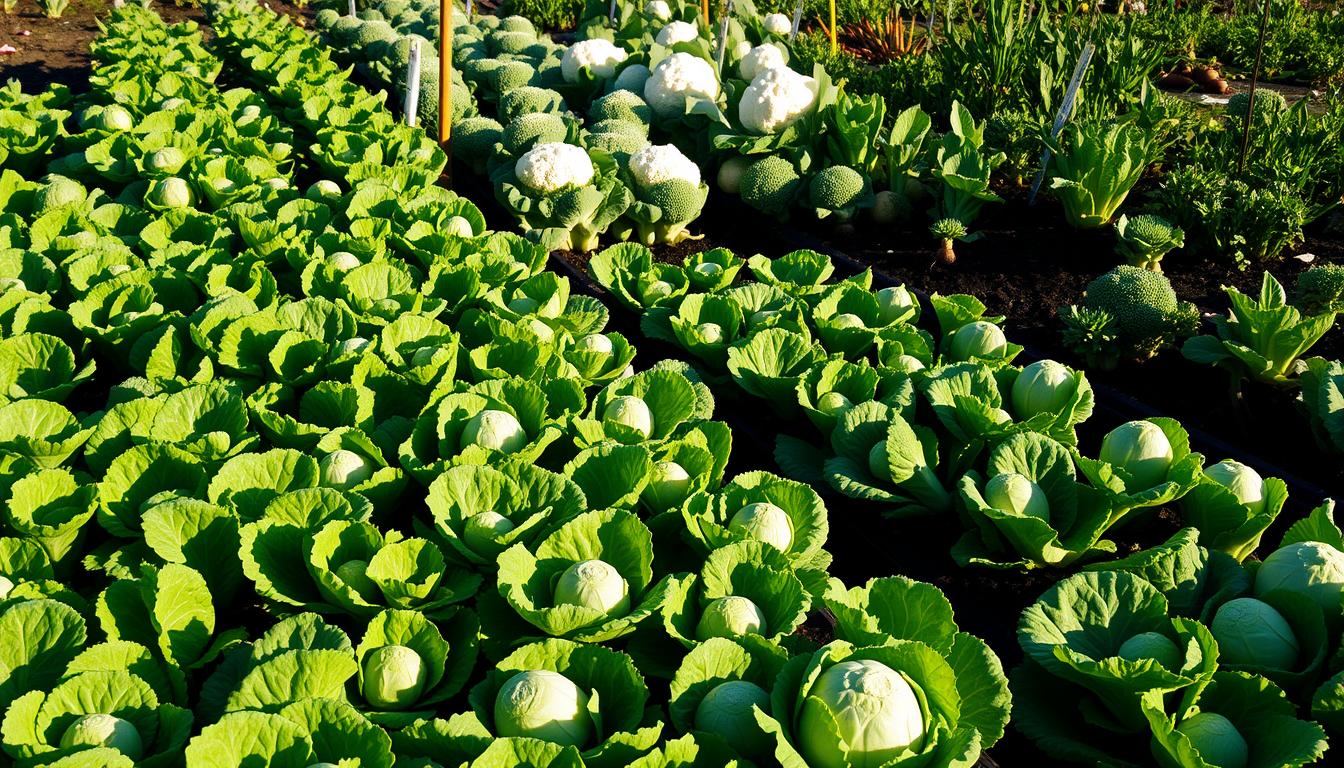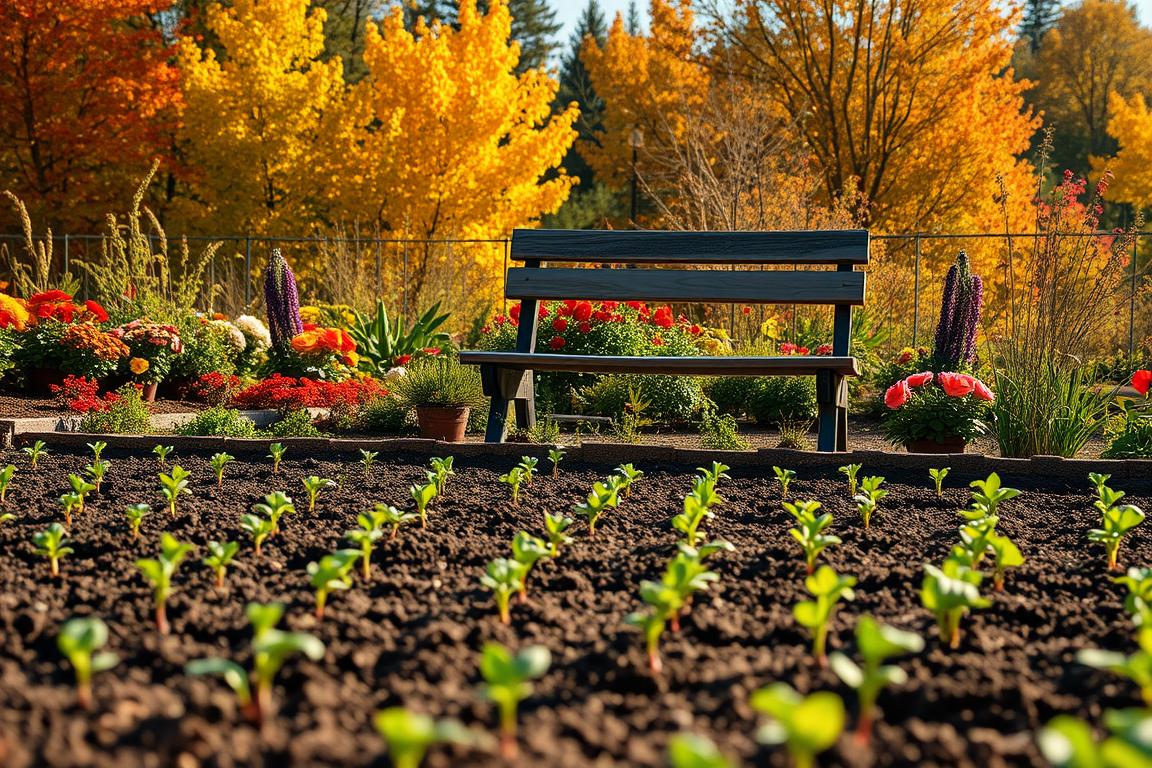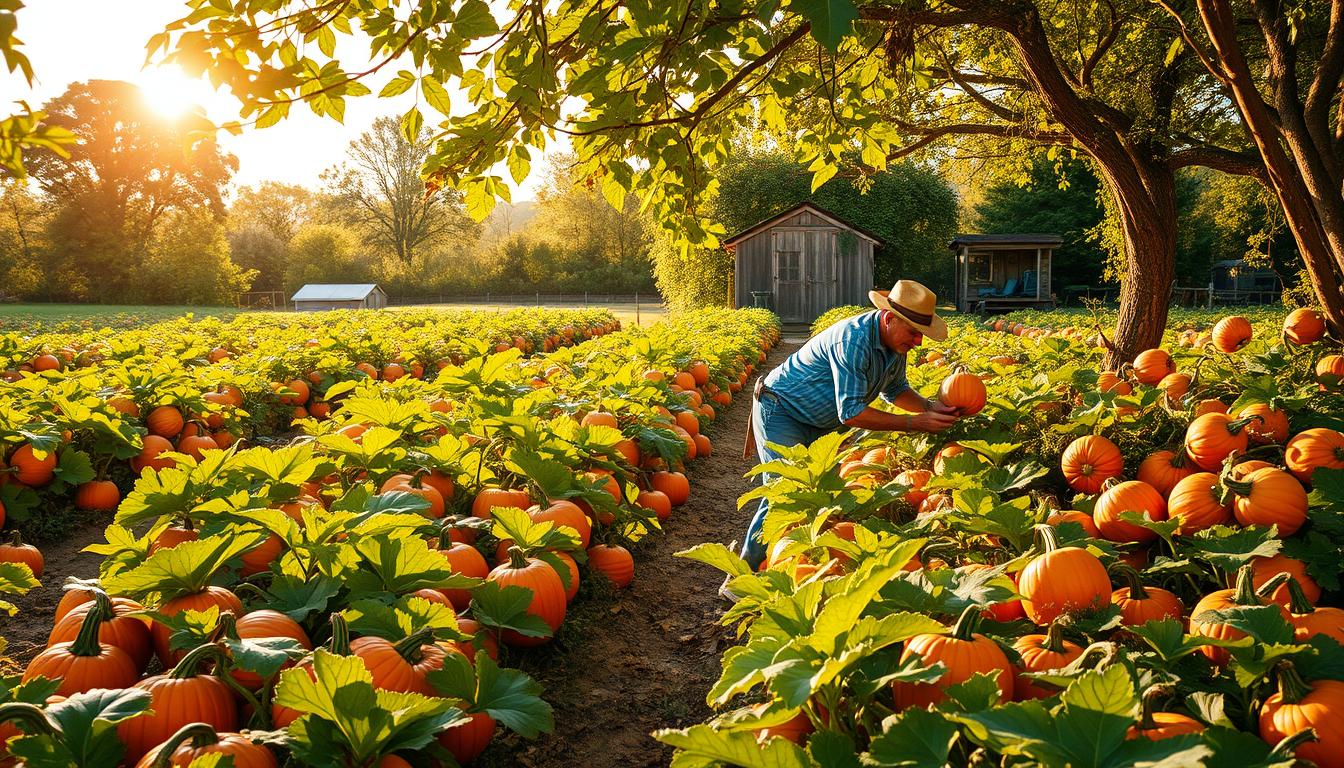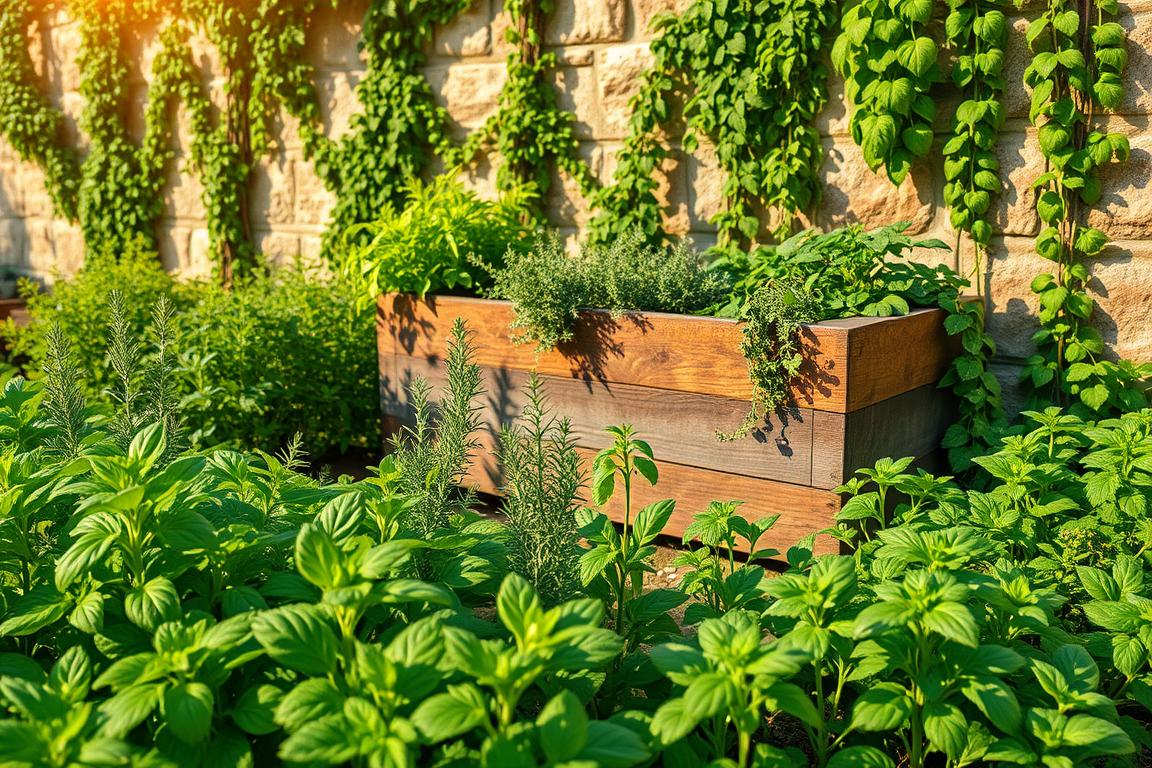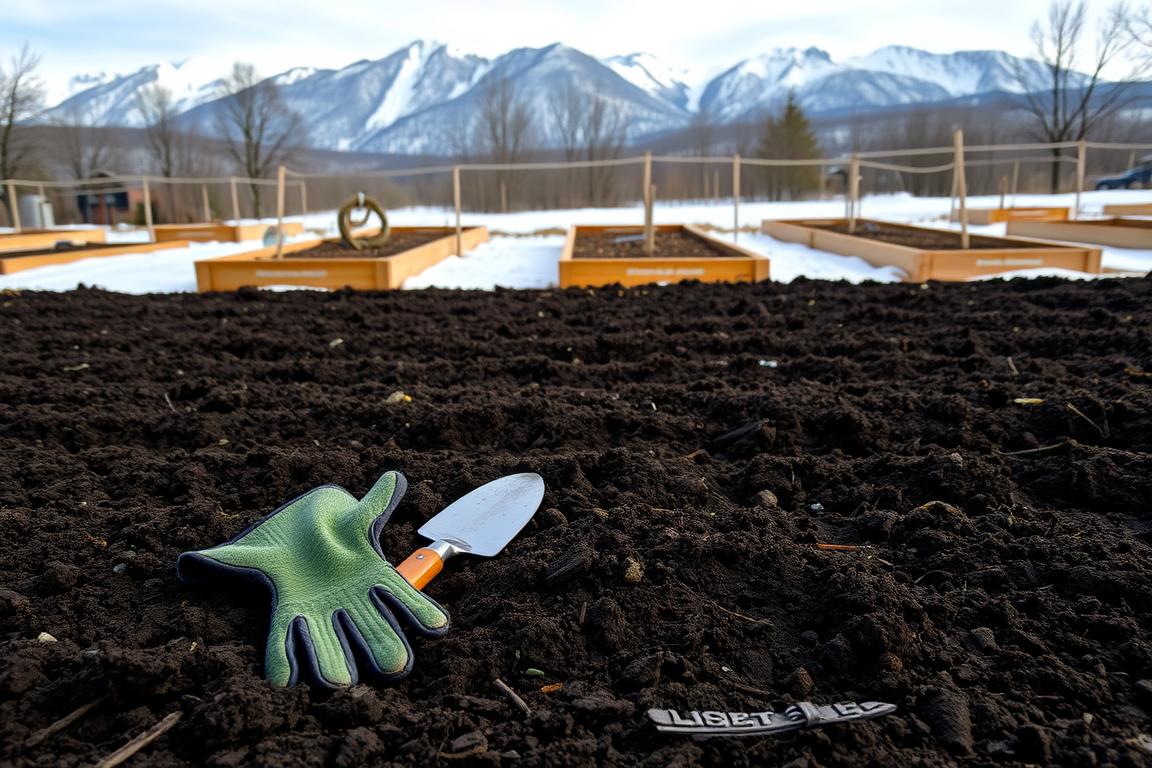Planting cold-weather crops extends the growing season and brings fresh produce all year. Top winter crops like spinach, kale, and carrots are perfect for a winter harvest. They can be planted in late summer for a fall harvest, making them ideal for a planting guide for cold weather vegetables. Beets and parsnips are also great for growing in cold weather.
Choosing the right vegetables is key when planting cold-weather crops. Lettuce and radishes are great for cooler temperatures. By following a planting guide for cold weather vegetables, you can have a successful harvest. Spinach is ready in 3 to 5 weeks, and kale takes about 60 days to mature.
Key Takeaways
- Plant cold-weather crops in late summer for a fall harvest
- Choose top winter crops like spinach, kale, and carrots
- Follow a planting guide for cold weather vegetables for a successful harvest
- Some of the best winter vegetables to grow are beets, parsnips, and lettuce
- Radishes can be ready to harvest in as little as 3 to 4 weeks
- Kale takes approximately 60 days to mature
- Spinach can be harvested in as little as 3 to 5 weeks
Understanding Cold-Weather Gardening Basics
Cold-weather gardening lets you grow crops that do well in the cold. The Old Farmer’s Almanac says these crops can handle light frosts. They can be planted in the fall or early spring. Broccoli, cauliflower, and kale are great examples.
When winter gardening, picking the right vegetables is key. Root veggies like carrots and beets stay in the ground all winter. They’re ready to harvest whenever you need them. Fast-growing greens like spinach and lettuce can be planted in late summer. They’re ready to eat in the fall, winter, or early spring.
To garden in the winter, you’ll need some special tools. Hoop houses, cold frames, and row covers protect your plants from the cold. With these tools and the right crops, you can have a winter garden full of fresh, healthy food.
- Extended growing season
- Fresh produce throughout the year
- Increased self-sufficiency
- Improved soil health
By using these tips and choosing the right crops, you can have a successful winter garden. It will be full of tasty, nutritious vegetables all winter long.
Best Cold-Weather Crops to Plant This Month for Maximum Yield
When planting winter vegetables, pick cold-hardy crops that do well in frost. The University of Georgia Extension suggests spinach, kale, and carrots for winter. These plants can be planted in late summer for a winter harvest.
Some top winter vegetables are spinach, kale, and carrots. These can handle frost and can be planted in late summer. For instance, kale grows well in 6″ to 8″ pots, planted in mid-July, and can handle frost.
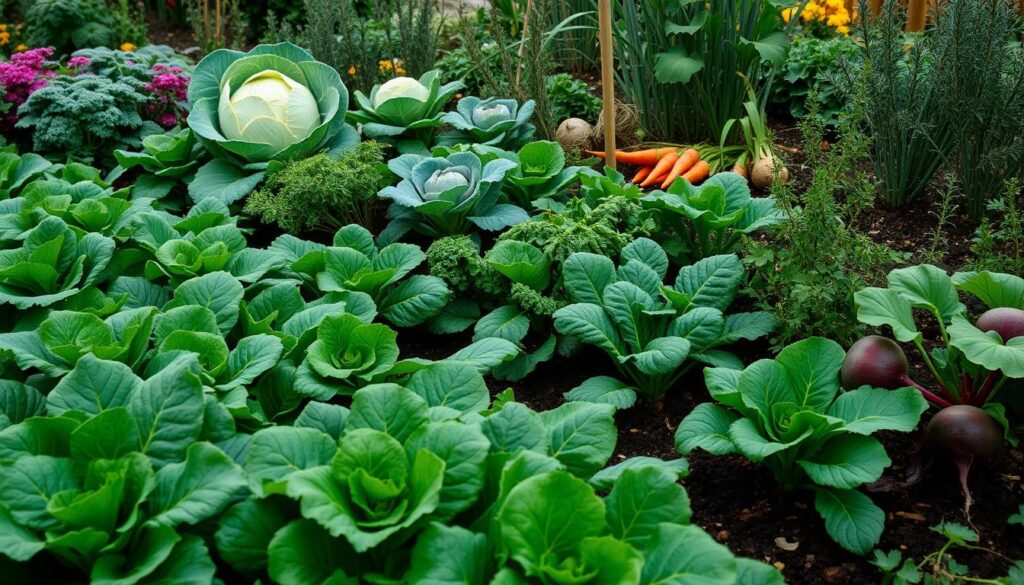
Other cool-season veggies like broccoli, lettuce, and cabbage also do well in cold. They can grow in pots from 6″ to 11″ and are ready to harvest in 30 days. Lettuce is ready in 45-50 days, and broccoli needs an 11″ pot because of its deep roots.
Planting these cold-hardy crops has many benefits:
- Weekly harvests of fresh veggies all winter
- Improved flavor and texture from frost
- Higher yield and productivity than warm-season crops
By growing spinach, kale, and carrots, you can have a rich harvest all winter. Choose frost-tolerant plants and plant them in late summer for a winter harvest.
Preparing Your Garden for Cold-Weather Planting
As winter comes, it’s key to get your garden ready for cold-weather planting. This means preparing the soil, protecting it from frost, and planning when to plant. The Old Farmer’s Almanac says that getting your garden ready for winter is vital for success.
First, pick the best crops for cold weather and plan your planting schedule for winter crops. Good choices include broccoli, kale, and carrots. Remember, check the average temperatures and how frost-tolerant your crops are.
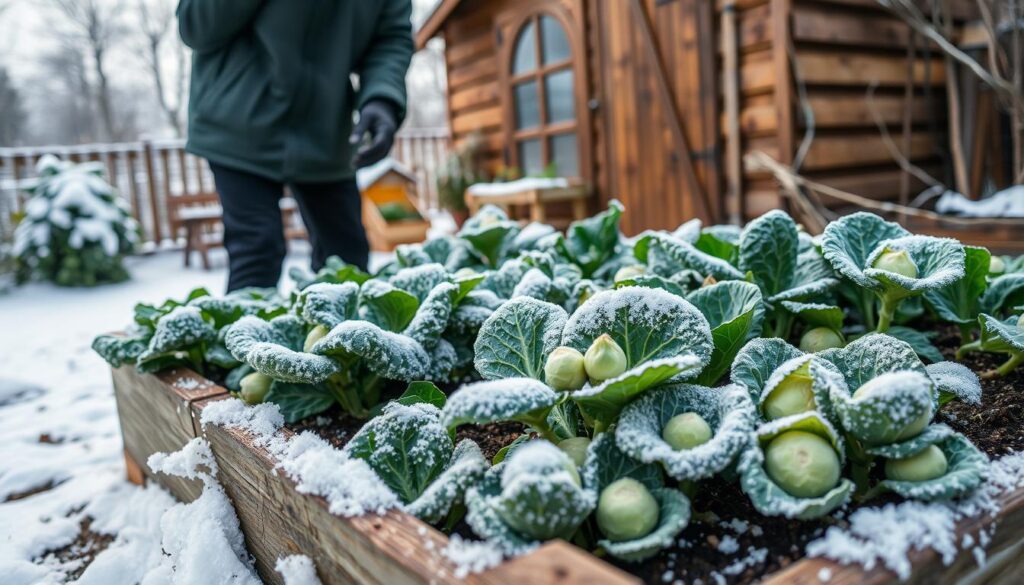
For soil prep, add compost or other amendments to enrich it. This makes your soil healthy and fertile for winter crops. Also, think about using row covers or cold frames to shield your plants from frost and extend the growing season.
Soil Preparation Techniques
Soil prep is a big deal for winter gardening. You need to test the soil’s pH and nutrient levels. Then, add organic matter like compost or manure to make it fertile.
Frost Protection Methods
Frost protection is also key for winter gardening. You can use row covers, cold frames, or other methods to keep your plants safe from frost and freezing.
Timing Your Planting Schedule
Timing your planting is critical for success. Look at the average temperatures and frost tolerance of your crops. Also, check the planting schedule for your area. By following these tips, you can have a thriving winter garden.
Root Vegetables for Winter Success
Root vegetables are a great choice for winter harvesting. The University of Georgia Extension says you can plant beets, turnips, and rutabaga in late summer. These hardy vegetables for winter do well in cold weather, perfect for winter crop rotation.
Root vegetables can handle temperatures as low as 15°F. This makes them great for vegetable gardening in winter. They can grow almost all year in zones 4 through 10. In zones 4 through 6, start winter vegetables in August and September. Zones 7 through 10 can plant seeds or transplant until early November.
Some popular root vegetables for winter gardening include:
- Beets
- Turnips
- Rutabaga
- Carrots
These vegetables need loose soil and the right fertilizer to grow. Too much nitrogen can make leaves big but roots small. So, use fertilizers rich in potassium or phosphorus.
Adding root vegetables to your winter gardening plan can give you a big harvest. With the right care, these hardy veggies will add flavor and nutrition to your meals all winter long.
Leafy Greens That Thrive in Cold Weather
Leafy greens are perfect for cold weather crops. They can grow in temperatures as low as 20°F. This makes them great for frost-resistant vegetables. Kale, spinach, and Asian greens are popular choices for winter gardens.
The Old Farmer’s Almanac says kale and spinach are great for cold weather. Kale can handle temperatures as low as 5°F. It needs at least 6 hours of sunlight to grow well. Spinach can grow in winter in zones 3-9 and can handle temperatures as low as 20°F.
Kale and Collard Varieties
Kale and collard greens are frost-tolerant and can survive temperatures down to the upper teens. They are excellent choices for winter gardens. They can be harvested in 30 to 60 days, depending on the variety and leaf size.
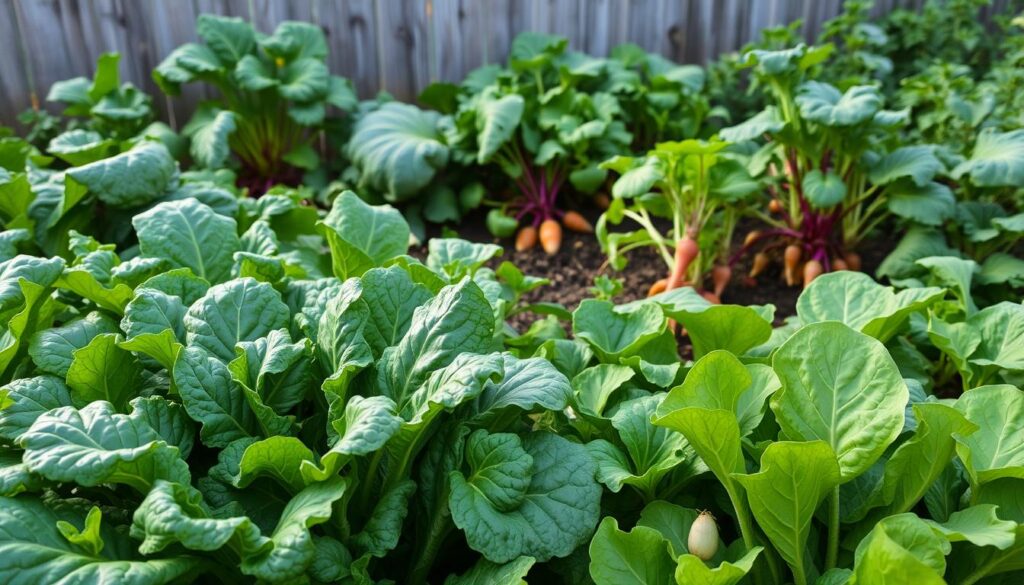
Spinach and Swiss Chard Options
Spinach and Swiss chard are also great for cold weather crops. Spinach can grow in temperatures as low as 28°F. Swiss chard needs soil temperatures of 75-90°F for best seed germination. Both can be harvested in 4-8 weeks, making them ideal for winter gardens.
Asian Greens for Cold Climate
Asian greens, like bok choy and mizuna, are also well-suited for cold weather. Bok choy thrives in USDA zones 4-7 during winter when protected from frost. Mizuna seeds can germinate in soil temperatures as low as 40°F. These frost-resistant vegetables add variety and flavor to winter gardens.
Protection Strategies for Your Winter Garden
As winter comes, protecting your garden is key. Frost protection is vital to keep your plants safe. Using row covers can also help your plants grow longer. The University of Georgia Extension says row covers and cold frames are great for this.
To keep your plants safe, try different methods. Mulch or hay around shrubs and trees can insulate roots. You can also cover plants with tarps, burlap, or buckets to shield them from snow and frost. For small perennials, use bamboo or metal stakes and twine to secure them.
Here are some tips for protecting your winter garden:
- Shovel snow off plants to prevent damage
- Use row covers to extend the growing season
- Implement frost protection methods like using cold frames
- Provide root insulation with a layer of mulch or hay
By using these strategies, you can keep your winter garden healthy. Always check your garden for damage from snow and frost. With the right methods and materials, your winter garden can thrive, even in cold climates.
| Protection Method | Description |
|---|---|
| Row Covers | Lightweight fabric covers that allow plants to breathe while protecting from frost |
| Cold Frames | Structures that use glass or plastic to cover plants, trapping heat and protecting from frost |
| Mulch or Hay | Layer of organic material that provides root insulation and protects plants from extreme temperatures |
Managing Your Cold-Weather Garden
As winter comes, it’s key to know the right winter gardening tips to keep your garden alive. Understanding your plants’ needs is vital. This includes knowing how to water, control pests, and when to harvest.
Some veggies like carrots and beets can handle the cold. They’re great for seasonal gardening tips in winter. But, other plants need extra help, like row covers, to make it through the frost.
- Water your plants wisely, as the soil dries out more in winter.
- Use smart pest control in winter methods, like picking pests by hand or natural remedies.
- Plan when to harvest carefully, thinking about each plant’s needs and how frost might affect them.
By using these cold weather gardening advice and seasonal gardening tips, you can have a lively and fruitful garden even in the harshest winters.
Conclusion: Growing Success in Your Winter Garden
To grow a successful winter garden, you need to plan well and take good care of it. Choose the right cold-weather crops and prepare your garden beds. Also, use effective protection strategies to enjoy a bountiful harvest, even in the coldest months.
Choosing hardy vegetables like kale, spinach, Brussels sprouts, and carrots is key. Make sure your soil is ready, plant at the right time, and protect your plants from frost. This will help your garden thrive in the cold.
Winter gardening offers many benefits, like fresh, nutritious produce all year. So, start growing your own winter garden today. Your taste buds and your green thumb will be grateful.
FAQ
What defines a cold-weather crop?
Cold-weather crops are veggies that grow well in cooler weather. They’re perfect for fall and winter gardens. These plants can handle frost and light freezes.
What are the benefits of winter gardening?
Winter gardening lets you grow food all year. It also lets you try crops that don’t do well in summer heat.
What essential tools and materials are needed for cold-weather gardening?
You’ll need good seeds, row covers, cold frames, and water. The right tools help your winter garden succeed.
What are the best cold-weather crops to plant this month for maximum yield?
Plant spinach, kale, carrots, beets, turnips, and leafy greens like Swiss chard. These grow well in cool weather.
How should I prepare my garden for cold-weather planting?
Improve your soil, use frost protection, and plan your planting. Good preparation helps your winter crops grow well.
What are some good root vegetable options for winter gardening?
Beets, turnips, and rutabaga are great for winter gardens. They grow in the fall and winter, giving you fresh food.
What leafy greens are best for cold-weather gardening?
Kale, spinach, and Asian greens are top choices for cold weather. They grow well in cool temps and give you a steady harvest.
How can I protect my winter garden from frost and harsh weather conditions?
Use row covers and cold frames to protect your garden. They help your crops grow longer and thrive.
What are some important tips for managing a cold-weather garden?
Follow watering and pest control tips, and time your harvests right. Doing these things helps your winter garden succeed.


